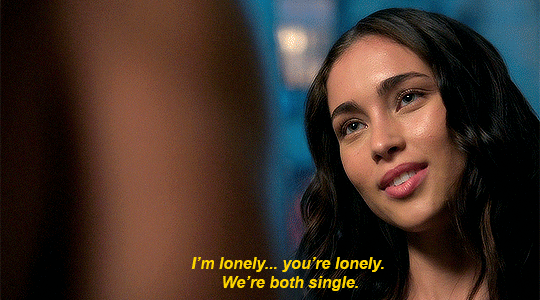Text
REVERSE TROPE WRITING PROMPTS
Too many beds
Accidentally kidnapping a mafia boss
Really nice guy who hates only you
Academic rivals except it’s two teachers who compete to have the best class
Divorce of convenience
Too much communication
True hate’s kiss (only kissing your enemy can break a curse)
Dating your enemy’s sibling
Lovers to enemies
Hate at first sight
Love triangle where the two love interests get together instead
Fake amnesia
Soulmates who are fated to kill each other
Strangers to enemies
Instead of fake dating, everyone is convinced that you aren’t actually dating
Too hot to cuddle
Love interest CEO is a himbo/bimbo who runs their company into the ground
Nursing home au
43K notes
·
View notes
Text
The Genie stared at you in disbelief, asking you why you would make such a foolish wish that affect so many people. You respond with a shrug and answer with “I just want to see what would happen.”
3K notes
·
View notes
Text
Let's talk about misdirection.
Misdirection in storytelling, through foreshadowing and other techniques, is a powerful tool that can enhance suspense, surprise, and engagement in your narrative and make plot twists more unexpected.
Remember to maintain coherence and avoid contrivances that may undermine the integrity of your storytelling.
Here are some techniques you can use to effectively misdirect readers:
Red Herrings: Introduce elements or clues that suggest a certain outcome or plot direction, only to later reveal that they were misleading. These false leads can divert readers' attention away from the true resolution.
Selective Detailing: Highlight certain details or events in a way that implies their significance, while downplaying or omitting others that might be more relevant to the actual outcome. By controlling what information readers focus on, you can steer their expectations.
Character Misdirection: Use characterisation to mislead readers about characters' true intentions, motivations, or identities. Create multi-dimensional characters who may behave ambiguously or inconsistently, leaving readers unsure of their true allegiances, motivations, or goals.
Foreshadowing: Employ foreshadowing to hint at future events or outcomes, but do so in a way that misleads interpretation. Provide clues that could be interpreted in multiple ways or that lead readers to expect one outcome while delivering another. (See my previous post about foreshadowing for more!)
Misleading Narration: Utilise an unreliable narrator or perspective to present events in a biased or distorted manner. Readers may trust the narrator's account implicitly, only to discover later that their perceptions were flawed or intentionally deceptive.
Subverting Tropes: Set up situations or scenarios that seem to follow familiar narrative tropes or conventions, only to subvert them in unexpected ways. This can keep readers guessing and prevent them from accurately predicting the story's trajectory.
Parallel Storylines: Introduce secondary storylines or subplots that appear unrelated to the main narrative but eventually intersect or influence the primary plot in unexpected ways. This can distract readers from anticipating the main storyline's developments.
Setting: Manipulate the setting or environment to create false impressions about the direction of the plot. For example, presenting a seemingly idyllic setting that harbors dark secrets or dangers.
Timing and Pacing: Control the pacing of your story to strategically reveal information or developments at opportune moments, leading readers to draw premature conclusions or overlook important details. (See my post on pacing for more tips!)
Twists and Reversals: Incorporate sudden plot twists or reversals that upend readers' expectations and challenge their assumptions about the story's direction. Ensure that these twists are logically consistent but sufficiently surprising to catch readers off guard.
Happy writing!
2K notes
·
View notes
Text
Some tips for using a few words to describe voices:
1. Tone Words: Use tone words to convey the emotional quality of a voice. For example, you can describe a voice as "melodic," "soothing," "sharp," "gentle," or "commanding" to give readers a sense of the tone.
2. Pitch and Range: Mention the pitch and range of the voice. Is it "deep," "high-pitched," "raspy," or "full-bodied"? This can provide insight into the character's age, gender, or emotional state.
3. Accent and Diction: Describe the character's accent or diction briefly to give a sense of their background or cultural influences. For instance, "British-accented," "Southern drawl," or "formal."
4. Volume: Mention the volume of the voice, whether it's "whispering," "booming," "murmuring," or "hushed."
5. Quality: Use terms like "velvet," "silken," "gravelly," "honeyed," or "crisp" to convey the texture or quality of the voice.
6. Rate of Speech: Describe how fast or slow the character speaks, using words like "rapid," "slurred," "measured," or "rambling."
7. Mood or Emotion: Indicate the mood or emotion carried by the voice. For example, a "quivering" voice may convey fear or anxiety, while a "warm" voice may express comfort and reassurance.
8. Resonance: Describe the resonance of the voice, such as "echoing," "nasal," "booming," or "tinny."
9. Timbre: Mention the timbre of the voice, using words like "rich," "thin," "clear," or "smoky."
10. Cadence: Highlight the rhythm or cadence of speech with descriptors like "staccato," "lilting," "rhythmic," or "halting."
11. Intonation: Convey the character's intonation by saying their voice is "sarcastic," "apologetic," "confident," or "questioning."
12. Vocal Characteristics: If applicable, mention unique vocal characteristics, like a "lisp," "stutter," "drawl," or "accented 'r'."
21K notes
·
View notes
Text
Writing Prompt #2645
He'd promised to take care of me. He said once I'd finished the work, that it would be just the two of us, and we could enjoy our time together.
But instead he abandoned me.
145 notes
·
View notes
Text






PRISCILLA QUINTANA and TOMMY MARTINEZ
Good Trouble (Season 3)
212 notes
·
View notes
Text
Fantasy Worldbuilding Questions (Fauna and Flora)
Fauna and Flora Worldbuilding Questions:
What are the most common animals or plants, the fly, pigeon, grass and weed equivalents in your world?
What are humans or others’ relationship to fauna and flora? (For example, are some groups more respectful, reverent, or caring of their environment? Why?)
Who in your cast of characters cares most about your world’s fauna and flora? Who cares least?
Who nurtures or exploits your world’s plant and animal life?
Where are plants and animals more abundant or scarce, and why?
Where do plants and animals get their names from?
When will plants or animals first appear in the story, and what will their purpose be in regard to character or plot?
When did common species of plants or animals first appear in your world, and how did they evolve or adapt?
Why do certain plants or animals have cultural or religious significance – what is their backstory in myth or legend?
Why do specific plants or animals have economic value, and how does their availability affect this value? Do these aspects change over the story’s course?
❯ ❯ ❯ Read other writing masterposts in this series: Worldbuilding Questions for Deeper Settings
183 notes
·
View notes
Text

some art of beidou i did for my little sister <3
61 notes
·
View notes
Text
things people do after having a nightmare that isn’t crying
struggle to catch their breath
grab onto whatever’s close enough to ground themselves in reality
become nauseous / vomit
shake uncontrollably
sweat buckets
get a headache
things people do to combat having nightmares if they occur commonly
sleep near other people so they can hear the idle sounds of them completing tasks
move to a different sleeping spot than where they had the nightmare
leave tvs / radios / phones on with noise
just not sleep (if you want to go the insomnia route)
sleep during the day in bright rooms
things people with insomnia do
first, obviously, their ability to remember things and their coordination will go out the window
its likely they’ll become irritable or overly emotional
their body will start to ache, shake, and weaken
hallucinate if it’s been long enough
it becomes incredibly easy for them to get sick (and they probably will)
add your own in reblogs/comments!
33K notes
·
View notes


















